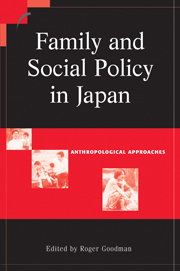Book contents
- Frontmatter
- Contents
- List of Illustrations
- Acknowledgements
- Contributors
- A note to the reader
- 1 Anthropology, policy and the study of Japan
- 2 Toward a cultural biography of civil society in Japan
- 3 Pinning hopes on angels: reflections from an aging Japan's urban landscape
- 4 Reproducing identity: maternal and child healthcare for foreigners in Japan
- 5 State, standardisation and ‘normal’ children: an anthropological study of a preschool
- 6 Child abuse in Japan: ‘discovery’ and the development of policy
- 7 Touching of the hearts: an overview of programmes to promote interaction between the generations in Japan
- 8 Death policies in Japan: the state, the family, and the individual
- 9 Embodiment, citizenship and social policy in contemporary Japan
- Index
2 - Toward a cultural biography of civil society in Japan
Published online by Cambridge University Press: 05 July 2014
- Frontmatter
- Contents
- List of Illustrations
- Acknowledgements
- Contributors
- A note to the reader
- 1 Anthropology, policy and the study of Japan
- 2 Toward a cultural biography of civil society in Japan
- 3 Pinning hopes on angels: reflections from an aging Japan's urban landscape
- 4 Reproducing identity: maternal and child healthcare for foreigners in Japan
- 5 State, standardisation and ‘normal’ children: an anthropological study of a preschool
- 6 Child abuse in Japan: ‘discovery’ and the development of policy
- 7 Touching of the hearts: an overview of programmes to promote interaction between the generations in Japan
- 8 Death policies in Japan: the state, the family, and the individual
- 9 Embodiment, citizenship and social policy in contemporary Japan
- Index
Summary
Since 1989, when civil society was credited with providing the space within which democratic reforms emerged after the fall of communism in Eastern Europe, the role of civil society has been the subject of an enormous amount of social science discourse. Japan's experience with both civil society and democracy has been vastly different from that of the states of the former Soviet bloc, yet the role of civil society in Japan has also become a major topic of discussion.
In Japan, the recent discourse on civil society emerged not from a fallen political philosophy but from the rubble of a disastrous earthquake. Early on the morning of January 17, 1995, a massive temblor hit the Hanshin region of central Japan. Initially, the government did almost nothing. It seemed frozen in a state of bureaucratic ossification caused by ministerial turf wars and disputes over jurisdiction between the central government and local authorities. With no systematic relief efforts in sight, small voluntary groups, small firms and their employees, and individual citizens, totalling approximately 1.2 million individuals, stepped in to fill the void by providing rescue, relief, and shelter. The earthquake starkly revealed both the inadequacies of the Japanese government's response to the disaster and the power of voluntary action to aid quake victims. Post-quake press on the volunteer effort produced more press coverage that brought more volunteers and yet more press. New volunteer groups sprang up and older unincorporated nonprofits (NPOs) grew more active.
- Type
- Chapter
- Information
- Family and Social Policy in JapanAnthropological Approaches, pp. 29 - 53Publisher: Cambridge University PressPrint publication year: 2002
- 3
- Cited by



